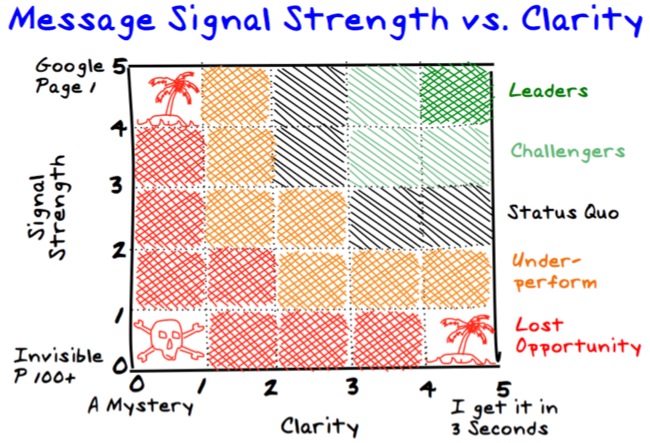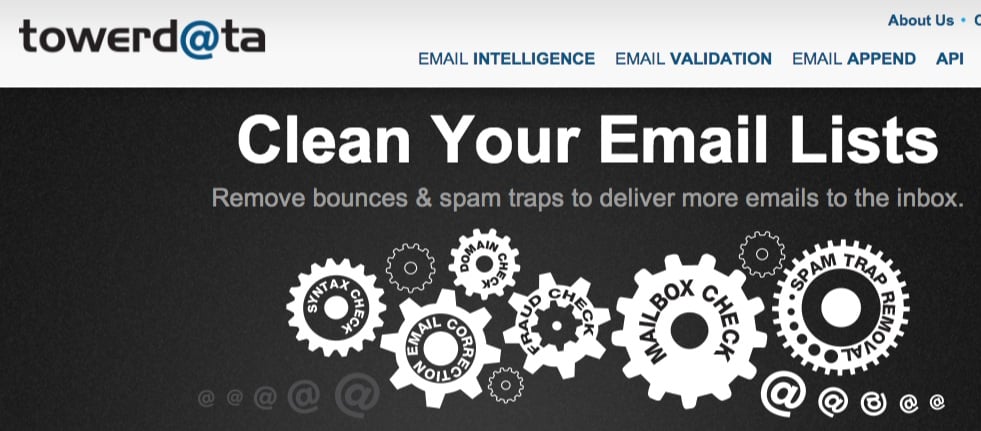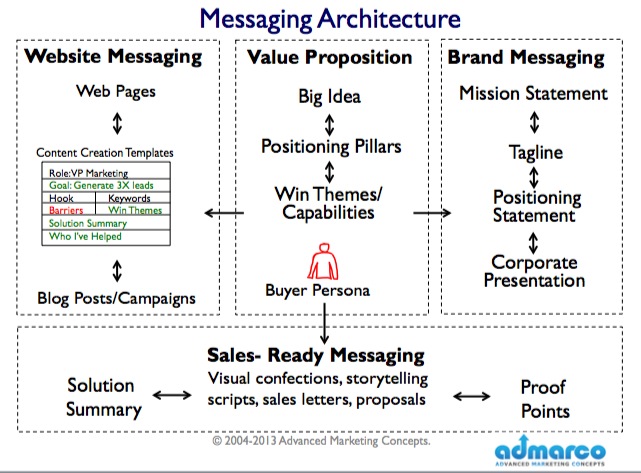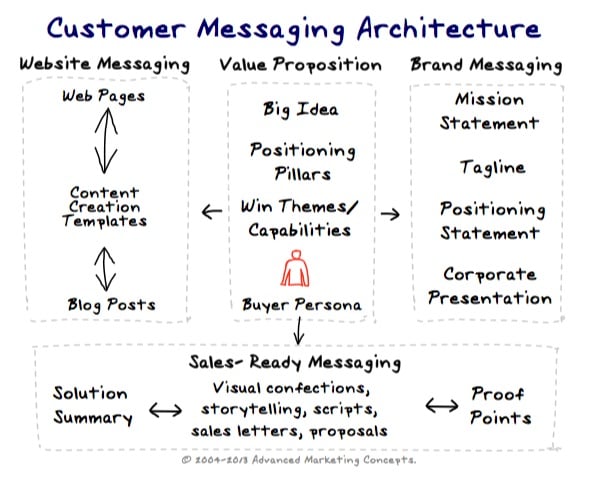4 min read
10,000 Reasons to get Clear about your Value Proposition
By Mark Gibson on May 13, 2022 12:00:00 AM
Topics: value proposition messaging architecture message clarity big idea
4 min read
Measuring Marketing Messaging Clarity and Effectiveness
By Mark Gibson on Apr 12, 2022 12:00:00 AM
How important is clarity in your messaging and how clear is your message?
I'd say it's the difference between life and death for start-ups.
Sales and marketing are dependent on the clarity of your message to win mindshare, generate leads; and to engage, diagnose and qualify new opportunities, yet clarity is often an afterthought.
I was prompted to write this article after a call this week with a technology company based in the Mid-West. This company has World leading technology, great vision and is completely failing in marketing.
They are in the red zone. When you arrive on their Website it is not possible to figure out that they do on the home page. Nor is it possible to figure out what they do by clicking on the CTA. You have to click on the product page to find the description of what they do and it's in 10 point font in the middle of the first paragraph. This is not a joke....this is a disaster.
Topics: sales and marketing alignment marketing messaging messaging architecture
5 min read
Tower Data Brand Messaging Update and Website Revamp Project
By Mark Gibson on Mar 13, 2022 12:00:00 AM
Email data solutions provider, TowerData went live with their redesigned Website last week, with a stunning new appearance and a message that grabs your attention after landing on any page on the Website.
TowerData Background
TowerData helps companies increase the performance of their email marketing by validating email addresses for improved deliverability, providing intelligence about email leads and subscribers, and increasing size of the email list. TowerData has been in business since 2001 and has helped thousands of customers improve their email marketing results and take their email list to the next level.
We created the new TowerData brand message in partnership with enterprise inbound marketing agency, Kuno Creative (Kuno), who created the redesign and new content and managed the website transformation project. Kuno is managing the content marketing, demand generation and marketing automation program for TowerData.
TowerData is a HubSpot customer and has already been successful with its demand generation activities, generating a predictable volume of inbound leads and doing well with keyword rankings. As a next step, TowerData wanted to attract and convert more qualified sales leads by improving its brand messaging and content.
Goal: Brand Update and Website Revamp
Tom Burke, CEO of TowerData stated, “the project was driven by a need to update and focus our brand and revamp our 6-year-old website.” Prior to the redesign the TowerData Website, although functional, looked dated and the message did not clearly identify how TowerData served its clients or what differentiated their services in a highly competitive market. TowerData sought to make its core service strengths readily apparent and easily understood by website visitors.
Complication: Prior History
TowerData had already identified a redesign and branding vendor who proposed a traditional approach of interviewing stakeholders, including TowerData customers, to understand the business, and pull out the themes and message from there. Our approach would involve more than a brand refresh.
Resolution: Create a Messaging Architecture
TowerData selected Admarco and Kuno for the messaging and Website transformation, and we began the project with the development of the TowerData Buyer-Persona, which details the roles and thought processes of representative buyers. The messaging process was done entirely over the Internet to save time and money and we used the MindManager tool from MindJet.com to capture the information in a brainstorming session attended by Kuno and top TowerData stakeholders.
With the Buyer Persona created, we moved to developing the Messaging Architecture and began brainstorming the Win Themes and Positioning Pillars.
The Messaging Architecture is developed by identifying product usage Win Themes, i.e. how the products are used to create value, solve problems and help buyers achieve their goals.
Win-Themes are self-describing information chunks that encapsulate feature, function and benefit in a meaningful sentence. In other words a Win-Theme describes what the product or service is, what does it does for the buyer when they use it and what that means in terms of value for the buyer. The brainstorming and review process required five Web Conferences to complete and took around about 10 hours to capture and edit over a period of 2 weeks.
Positioning Pillars are used to position the product in the market vs. competition. Some of our clients are unsure of their Pillars at the start of the process, but in TowerData’s case they knew they wanted to position around Email Append, Email Intelligence and Email Validation.
Topics: messaging architecture brand messaging content creation towerdata kuno creative
3 min read
5 Steps to Creating Marketing Content that Resonates with Buyers
By Mark Gibson on Jan 13, 2022 12:00:00 AM
Weak Marketing Kills Dreams and Companies
Innovation in our culture is constant, with exciting products created in start-up companies, or incubated in existing corporations, that promise to enhance our productivity and enjoyment of life.Most of these companies won't make it out of start-up mode and the underlying IP will either get sold for pennies on the dollar, or product sales will limp along until the product is finally killed-off.
There are myriad possible causes for failure, but one common thread is a lack of awareness in the potential buying audience, because the problem solving capability or potential to create value is invisible in Internet searches. If keywords containing your brand and product names are the primary sources of the little organic traffic you do get, then you have a problem, because buyers who don't know your brand or product cannot and will not find you.
This problem is not reserved for start-ups, I have seen it dozens of times in Silicon Valley in SMB companies ranging from ten million to half a billion dollars in revenue.
Sales and marketing fiefdoms and a lack of collaboration on messaging can lead to two different and fuzzy languages being spoken to the customer and buyers being left to figure out for themselves how the products could create value in their environment.
Today there are very effective ways of getting products into the hands of buyers and
Topics: marketing messaging messaging architecture content creation templates
3 min read
What's in Rolls Royce Brand? - What is your Brand Value Proposition?
By Mark Gibson on Oct 27, 2021 11:23:06 AM
A large assortment of some of the World’s finest cars came to my home town last week for the annual Concourse de Elegance in Pebble Beach.
On Tuesday afternoon about 200 cars were on display in Ocean Avenue, Carmel for the non-paying public to get up close and kick the tires (I don’t think so). With so many wonderful machines from the past century of motoring in better than showroom condition, I was given to ask, “What is the most prestigious and enduring brand for any motor car, for the past 100 years?”
There are only a handful of manufacturers still around around after 100 years that are still going, let alone one that is 97 years old and one of the World's Superbrands. One brand in my opinion rises above them all - and that is Rolls Royce. I then asked myself the question, “what’s in the brand Rolls Royce…what does it mean to own one, who buys them and why?”.
A bad photograph of a beautiful pre-WW2 Rolls Royce drop-head coupe that inspired this article.
Topics: messaging value differentiation messaging architecture branding
5 min read
Shelby Cobra - Brand Marketing with Adrenaline
By Mark Gibson on Oct 27, 2021 11:23:06 AM
Old School - "Mad Men", Top-down Branding
The marketing World is always evolving, and one of the most notable shifts in recent years has been the move from the outbound marketing era's “top down” branding approach to the more inclusive buyer-centric messaging favored by savvy startups, marketing innovators and companies utilizing inbound marketing to drive sales.
Topics: messaging architecture marketing message brand message
6 min read
Your Sales Problem is not the Problem, it's in Marketing
By Mark Gibson on May 2, 2013 12:00:00 AM
The Symptoms are not the Problem
I have detected a pattern in our inbound lead generation that indicates a typical problem in mid-sized SMB technology companies. The problems can be rectified within a few months and relatively inexpensively, once it has been correctly identified and stakeholders are on-board. The outcome from fixing the problem will positively affect the future of the company. I'm going to describe company X, a lead that came in last week with the problem and how we go about identifying the cause and solving the problem.Company X founders have long since moved-on and the company is no longer the darling of the investment community and is possibly owned by a Private Equity company who are interested in flipping it as soon as possible.
The business is hard-won and the methods are traditional. Revenue growth has flat-lined and every quarter is a struggle, as is hiring and keeping good sales talent. Multiple CEO's, sales VP's and many salespeople have passed through the halls of Company X in the last 2 years. New agile competitors are attacking the installed base and leads are few and far between.
Do you have enough Leads? - No
The inbound inquiry (lead) I receive in my HubSpot Inbound Marketing system comes from the sales leader typically, although it can come from the marketing director. The inquiry is usually for a sales performance related whitepaper and symptoms of the problem are nearly always "sales aren't making their numbers" or "weak pipeline". The first question I ask is, "what is the problem that is causing the weak sales effect?" The answer is often silence or head-scratching and then I ask if there could be a lead generation problem....to which the answer is nearly always - yes.A quick look at our visitor's Website and I form an opinion that is then validated through running a couple of reports. Do the following describe your Website?;
- A Scrolling montage of smiley faces, screen shots and captions that are coupled with abstract product features or benefit statements that presume the visitor has prior knowledge of the company products and services.
- There is no Big-Idea where I can "get what the company does" and how they create value for their customers.
- Drilling down on menu items indicates the markets they serve, but it leads to more product-centric capabilities and I still can't figure out what the company does and why I would want to work with them. I can download a whitepaper, but why would I?, - other than curiosity, there is no compelling reason to.
- There is no blog, so I look at the news to get some insight, and the last article was published 6 months or more ago.
- Finally I revert to customer testimonials and out of the mouth of one of the customers comes the product-usage value statement.
Suspicions Confirmed - it's a Marketing Problem
I then run a marketinggrader report and my suspicions are confirmed as the company scores a Website grade of less than 50/100...in Company X case they scored 38/100.I know after reading this report that the company is getting very few inbound leads. They are virtually invisible on the Internet to potential prospects who are looking for products with similar capabilities to Company X to solve problems.
I also know that if we examined the effectiveness of their keywords, that their few traffic producing keywords would contain the company product name and their product names, few others. What is really distressing is that the company typically has really solid technology products, backed by great pre-sales and support people.
There is no marketing VP and the marketing director is pulling her hair out or looking for another job. The company is spending a lot of its marketing budget on pay-per-click ads and also uses a 3rd party to generate appointments for the sales team.
They may have a marketing automation platform installed, but t hey admit they are underutilizing its capability and p aying too much for it considering the meager flow of leads. I t is basically being used as an email engine blasting to their installed base and lists they acquired.
Where to From Here?
When I ask Prospect X to rate the clarity of the company message, it's usually a 4 or 5 out of 10....but they want to be a 9 or a 10.Then I ask how they rate the sales teams ability to clearly communicate value to the prospective customer and the answer is typically 3-4 out of 10, but they want to be an 8-9/10. Now we have a problem we can deal with.
- The reasons salespeople fail are myriad, but what if they had a stream of well qualified leads?
- What if instead of just a few talented members of the sales team succeeding, everyone on the sales team could communicate clearly and confidently with propects?
- What if the money being spent on sourcing appointments and the non-functioning marketing automation platform could be diverted into a proven Inbound Marketing platform and sustainable methodology for generating and nurturing quality leads?
- It is difficult to imagine spending lavish sums on rebranding or a marketing agency to redevelop the company X message, where every marketing dollar is closely scrutinized, but what if the message could be made to resonate with buyers with a little outside help?
- What if the sales team had a compelling value-creation story they could all tell and skills to engage prospective buyers that did not rely on the use of PowerPoint?
Brand Messaging and Positioning
Al Ries in the book "Positioning" suggests rather than try and create something new and different in the mind of the buyer, we need to manipulate what is already there and retie the connections that already exist.A methodology for consistent value messaging that resonates with buyer needs is built from the bottom-up, based on connecting value-creation to buyer-needs. The chart below represents our latest thinking on this important subject.
- Start your journey to clarity in messaging value with a sales and marketing messaging alignment workshop. The output of this process is Messaging Architecture that will help marketers and salespeople position capabilities and engage buyers in conversations around their problems vs. the product features.
- Identify your buyer-persona's and their roles, goals, issues and problems that your products/services can address
- Next, map your relevant capabilities that can help buyer persona's solve their problems
- Group Win-Themes into logical clumps and abstract the positioning pillars to create clarity in positioning vs competition.
- At this point we will have enough information to form the basis of a visual confection and visual story that salespeople can use to engage buyers in conversation around their issues.
- With the Value Proposition in place, the Brand Message including mission-statement, tagline, corporate positioning and corporate story can easily be derived.
- Content Creation Templates extract Win Themes and Buyer Persona issues and appropriate keywords and are used to develop consistent content for both blogging and Website pages by insiders as well as external writers.
- Creating a "Mission Statement" that helps employees connect their daily toil with company vision, revenue, profit and customer satisfaction goals will resonate with customers more than "to be good corporate citizens" and "to maximize stockholder value".
- Creating a positioning statement identifies the market segment you wish to occupy in the mind of the buyer and why your product/service is different and valuable.









